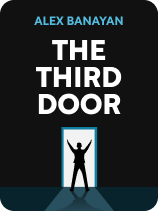

This article is an excerpt from the Shortform book guide to "The Third Door" by Alex Banayan. Shortform has the world's best summaries and analyses of books you should be reading.
Like this article? Sign up for a free trial here.
How does Laga Gaga respond to criticism? What does Jane Goodall’s story teach us about the career challenges that women face? Why isn’t Quincy Jones afraid to make mistakes?
Alex Banayan interviewed several successful people for his book The Third Door. Many of them told stories of overcoming difficult challenges to success. Lady Gaga, Jane Goodall, and Quincy Jones gave Banayan insights on how to bounce back from setbacks so that you don’t derail your progress.
Keep reading to learn how each of these people achieved success despite major challenges.
1) Lady Gaga: See Your Mistakes as Strengths
Banayan wasn’t able to sit down with Lady Gaga for an official interview, but he did meet her briefly and, through a mutual acquaintance, became involved in planning her media response to the criticism of her recently released album. He got some insight into how she faces challenges to success by watching how she handled that criticism. He learned that, if you have a strong sense of your values, you can spin your failures as successes as long as they align with those values.
The phenomenal success of her first two albums made Gaga a worldwide star, but critics panned her third album, ARTPOP, and sales were low. For several months after the album’s release, Gaga struggled to respond to this criticism, and the negative reviews were hard on her. However, she ultimately realized that the unusual character of her album—which is what prompted the negative reviews—was consistent with her brand of always defying expectations. Since her previous albums had been so well-received, it was fitting that she then release an album that appealed more to a fringe audience.
By embracing the message that the low sales and bad ratings of the album actually reflected its underlying strengths, Gaga was able to emerge from the experience with a sense that she was in control of the narrative. She even ramped up the strangeness of the album by making all-the-more bizarre performances, including having someone vomit on her on stage. She publicly compared this strangeness to Andy Warhol’s art, thus positioning her album alongside recognized great art.
2) Jane Goodall: Women Face Different Pressures
When Banayan sat down with primatologist Jane Goodall, he was confronted with a challenge that his male interviewees hadn’t had to face: sexual harassment. His lesson from this encounter was less about how to recover from these kinds of challenges, and more about his own recognition that they happen—before his conversation with Goodall, he didn’t consciously realize that women face unique disadvantages in the workplace.
Early in her career, Goodall landed a job as an assistant to Louis Leakey, a renowned paleoanthropologist with valuable knowledge and connections. Leakey was in a position to greatly further Goodall’s career, but he made sexual advances to her, putting her in a difficult position: If she rejected his advances, would he block her career progression?
Fortunately, Leakey stopped making advances when Goodall made it clear she wasn’t interested. He went on to fund her studies, which allowed her to live in the jungle and make the discoveries that changed science’s understanding of primates.
Banayan had a difficult time understanding Goodall’s attitude toward the experience. She brushed it off as just “something that happens,” which clued him in to the different dynamics women face in the workplace and the fact that they must successfully navigate obstacles that men don’t.
| The Subtle Sexism of Banayan’s Goodall Interview Goodall’s experiences of navigating unwanted sexual advances from men were by no means unusual, especially in the 1960s when she started her career. But, was Banayan’s almost-exclusive focus on that aspect of her work a different type of sexism? It might be argued that his emphasis on those experiences is an example of subtle sexism—the well-intentioned but still-harmful attitude that frames women in positive terms but by their gender first and capabilities second. An example of subtle sexism is if a male coworker tells a woman he’s happy to have her on the team because he needs a “mom” to keep him organized—this kind of comment diminishes a woman’s achievements while purportedly complimenting them, and frames her as a “female” team member instead of just a “team member,” thereby excluding her from the “norm.” Banayan doesn’t go into detail about any challenges Goodall faced other than the sexual harassment, nor does he seek insights about her success, accomplishments, or worldview that led her to her groundbreaking discoveries, as he does with his other interviewees. Instead, his talk with Goodall ends up being a tool for him to come to a deeper understanding of himself and his male-centered outlook on the world. Goodall’s career was, of course, significantly impacted by the fact that she was female in a male-dominated, science-oriented field, and she herself has discussed the benefits that this brought her along with the challenges. But Banayan’s focus on how her struggles made him feel may have ironically continued the gender-based diminishment of her achievements. |
3) Quincy Jones: Focus on the Journey, Not the Destination
Banayan’s interview with legendary music, film, and television producer Quincy Jones taught him a healthy way to recover mentally and emotionally from mistakes and setbacks: Jones argued that the important aspect of your pursuit of success is the journey itself, not the end result, and that, if you approach your career with that attitude, you’ll see mistakes as a step along the way instead of an ending point. In this way, you should focus on growth and effort, not outcomes.
Jones said that, when you accept mistakes as part of the process, you’ll stop being afraid to make them, which can help keep you motivated to get through difficult times. If you’re afraid to make a mistake, you won’t challenge yourself, which will limit how much you achieve.
Banayan realized that this lesson applied to his journey in writing his book. He’d endured many failures and had made many mistakes (for example, asking the wrong interview questions, not listening properly, and being too aggressive and thus putting people off). But those mistakes had taught him more than anyone’s wisdom had taught him.
| How Focusing on Effort Helps You Accept Mistakes Jones isn’t the only person to advise focusing on growth and effort instead of outcomes and results. Jones’s advice pertained to finding success in business, but the approach can influence how you work toward any goal—for example, it mirrors the approach, discussed earlier, that Jessica Alba took to improving health: Focus on what you can control. The ancient Stoics recommended this approach as a way to find happiness in general, as William Irvine explains in A Guide to the Good Life. They recommended focusing on your own effort, which you can control—you can choose how much time and resources to devote to a project—because if your project involves other people, you can’t fully control the outcome since other people may do things differently than you’d like. When you adopt this mindset, you can reduce your fear of mistakes because you can see them as part of your effort—part of your journey—and you can recognize that your journey doesn’t have to end because you’ve made an error. You’ll see that when you make a mistake, it will teach you what to do better so that you can then stay more in control of your effort and process. In Principles, Ray Dalio takes this idea further by defining mistakes as nature’s way of telling us to keep learning. He sums up the relationship between mistakes and achievement with the equation: Pain + Reflection = Progress. This idea again focuses on progress instead of outcomes, and it also incorporates reflection, which is, ultimately, the lesson Banayan took away from the experience of writing his book: Mistakes afford opportunities for reflection that lead to learning. |

———End of Preview———
Like what you just read? Read the rest of the world's best book summary and analysis of Alex Banayan's "The Third Door" at Shortform.
Here's what you'll find in our full The Third Door summary:
- That there are three doors in life—but most people only know about two
- Insights, tricks, and motivations to help you find your path to success
- Advice from some of the world's most successful people






